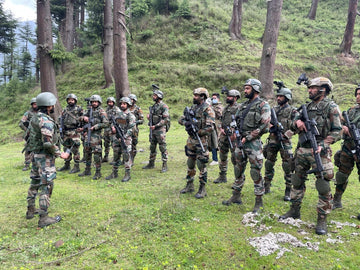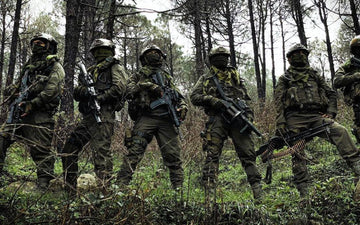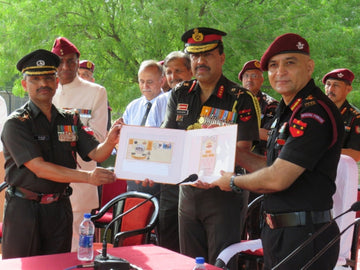The Indian Armed Forces boast an array of specialized units, among which the PARA (Special Forces) stands out for its elite status and formidable capabilities. Known for their extraordinary skills and prowess in high-stakes operations, these battalions play a pivotal role in India’s national security strategy. Each PARA battalion, with its unique nickname, role, and legacy, contributes significantly to diverse operational requirements, from counter-terrorism to urban warfare. In this article, we will explore the intricacies of the PARA SF battalions: their nicknames, roles, historical significance, and enduring legacy.
Historical Context
The origins of the PARA units can be traced back to the Indian Army's early years, through periods of significant transformation shaped by conflicts, operational demands, and changing security paradigms. The 1st PARA was raised in 1761, making it one of the oldest regiments in the Indian Army. Over the centuries, these units have evolved, adapting to new challenges presented by the complex geopolitical landscape India faces today.
The transition of these battalions into Special Forces units, predominantly in the late 20th and early 21st centuries, marks a critical evolution in their operational focus. As global counter-terrorism strategies intensified, the need for highly trained special operations forces became apparent. This led to a systematic restructuring and specialization of several battalions, enabling them to undertake complex operations involving unconventional warfare, surveillance, reconnaissance, and intelligence-gathering missions.
Overview of PARA SF Battalions
1. 1 PARA SF: The Red Devils
-
Nickname: Red Devils, Pratham’s
-
Role: Urban Warfare
-
Established/Converted: Raised in 1761, converted to SF in 1978.
1 PARA SF stands as a stalwart of urban warfare within the Indian Army's elite. The nickname "Red Devils" is fitting for a unit known for its quick strikes and operational efficiency in densely populated areas. The battalion has been involved in various high-profile operations, particularly in urban settings where intelligence and stealth are paramount.
2. 2 PARA SF: The Predators
-
Nickname: Predators
-
Role: Mountain Warfare, Counter Insurgency/Counter Terrorism
-
Established/Converted: Raised in 1797, converted to SF in 2000.
Equipped to handle the rigors of mountainous terrains and counter-insurgency operations, 2 PARA SF has earned the nickname "Predators." This battalion specializes in striking hard against insurgent activities, particularly in regions like Jammu and Kashmir.
3. 3 PARA SF: Russell’s Viper
-
Nickname: Russell’s Viper
-
Role: Desert Warfare
-
Established/Converted: Raised in 1813, converted to SF in 2002.
Known for its operations in arid and challenging environments, 3 PARA SF operates with efficiency in desert warfare. The nickname "Russell’s Viper" symbolizes the battalion's ability to execute swift operations in hostile territories.
4. 4 PARA SF: The Mighty Daggers
-
Nickname: Mighty Daggers, Four of the North
-
Role: Counter Terrorism, Counter Insurgency
-
Established/Converted: Raised in 1961, converted to SF in 2003.
This battalion is renowned for its contributions to counter-terrorism operations, particularly during significant military actions like the Surgical Strikes in 2016. Their resolve in the line of duty is encapsulated in the nickname “Mighty Daggers,” a representation of precision and effectiveness.
5. 5 PARA SF: Batalik
-
Nickname: Batalik
-
Role: Mountain Warfare, Counter Insurgency
-
Established/Converted: Details on establishment not specified.
Designed for operations in high-altitude and rugged terrains, 5 PARA SF, also known as Batalik, showcases significant adeptness in mountain warfare, pivotal in regions like Ladakh.
6. 6 PARA SF: Sakht Para
-
Nickname: Sakht Para
-
Role: Counter Terrorism, Counter Insurgency
-
Details: Known for its robust operations.
6 PARA SF is a battalion that encapsulates strength in its operations, engaging in counter-terrorism and insurgency combats as directed by national interests.
7. 7 PARA SF: SE7EN
-
Nickname: SE7EN
-
Role: Counter Terrorism, Counter Insurgency
-
Details: Specializes in counter-terrorism and counter-insurgency operations.
As part of their operational repertoire, 7 PARA SF has gained traction for their specialized tactics in dealing with terrorism, providing pivotal support in various critical scenarios.
8. 9 PARA SF: Mountain Rats
-
Nickname: Mountain Rats, Ghost Operators, Pirates
-
Role: Counter Terrorism, Counter Insurgency
-
Established/Converted: Raised in 1966.
Completing various successful operations, including the Surgical Strikes along the Line of Control, 9 PARA SF has earned respect as "Mountain Rats," indicating their adaptability in challenging terrains.
9. 10 PARA SF: Desert Scorpions
-
Nickname: Desert Scorpions
-
Role: Desert Warfare, Counter Insurgency
-
Established/Converted: Raised in 1967.
Famed for their expertise in desert warfare, 10 PARA SF engages heavily in counter-insurgency operations, using the unique characteristics of arid environments to their advantage.
10. 11 PARA SF: Vipers
-
Nickname: Vipers
-
Role: Jungle Warfare, Counter Insurgency
-
Established/Converted: Raised in 2011.
Specializing in jungle warfare, 11 PARA SF (Vipers) is adept at navigating forested terrains where stealth and speed become critical in engagements.
11. 12 PARA SF: Dirty Dozens
-
Nickname: Dirty Dozens
-
Role: Jungle Warfare, Mountain Warfare, Counter Insurgency/Counter Terrorism
-
Established/Converted: Raised in 2011.
This battalion is diverse in capability, prepared for operations in both mountains and jungles, showcasing versatility in tackling insurgency efforts.
12. 21 PARA SF: Waghnaks
-
Nickname: Waghnaks
-
Role: Jungle Warfare, Mountain Warfare, Counter Insurgency/Counter Terrorism
-
Established/Converted: Raised in 1985, converted to SF in 1996.
The Waghnaks have earned a reputation for effective operations in jungles and mountainous areas, showcasing commitment and resilience in counter-terrorism missions.
13. 23 PARA SF: Devil’s Own
-
Nickname: Devil’s Own
-
Role: Jungle Warfare
-
Details: Specializes in jungle warfare operations.
Known for their innate proficiency in jungle warfare, 23 PARA SF thrives in environments where engagement strategies hinge on stealth and adaptability.
14. 29 PARA SF: Airborne Rajputs
-
Nickname: Airborne Rajputs
-
Role: Counter Insurgency/Counter Terrorism operations
-
Details: Known for its airborne and counter-insurgency capabilities.
With a legacy of airborne operations, 29 PARA SF has gained recognition for their impactful counter-terrorism strategies, fortifying the Indian Army’s special operations capabilities.
Roles and Specializations
The PARA battalions are not just defined by their nicknames but also by their meticulously crafted roles tailored to address specific operational needs. Each unit specializes in different forms of warfare, enhancing their overall effectiveness in various situations.
Urban Warfare
1 PARA SF (Red Devils) excels in urban environments, where their training allows them to carry out surgical strikes against hostiles while minimizing collateral damage. Their skills are particularly crucial during hostage rescue operations and anti-terror campaigns in major cities.
Mountain Warfare
The rugged terrains of the Himalayas necessitate specialized training, and battalions like
2 PARA SF (Predators),
5 PARA SF (Batalik), and
9 PARA SF (Mountain Rats) have honed their skills to conduct operations at altitude, where the challenges of cold weather combat are intensified.
Desert Warfare
Battalions such as
3 PARA SF (Russell’s Viper) and
10 PARA SF (Desert Scorpions) command expertise in operations within arid zones, tackling insurgent threats that often leverage the desert terrain to their advantage.
Jungle Warfare
Units like
11 PARA SF (Vipers),
12 PARA SF (Dirty Dozens),
21 PARA SF (Waghnaks), and
23 PARA SF (Devil’s Own) are trained to conduct stealth operations in dense jungle terrains, where visibility is limited and encounters are often close-quarters.
Counter Terrorism/Counter Insurgency
Various units within the PARA SF battalions engage primarily in counter-terrorism and counter-insurgency efforts, including
4 PARA SF (Mighty Daggers),
9 PARA SF (Pirates), and
6 PARA SF (Sakht Para). These units often operate in conflict zones to dismantle terror networks and reclaim stability for affected populations.
Legacy and Operations
The legacy of the PARA battalions extends beyond their specialized training; it encompasses the valiant stories and high-stakes operations that define their existence. Many of these units have historical significance, having participated in crucial military engagements since the British era.
Surgical Strikes
Two notable examples of the PARA SF’s capabilities were showcased during the
2016 Surgical Strikes across the Line of Control following a terror attack in Uri. Both
4 PARA SF and
9 PARA SF were instrumental during this operation, illustrating the effectiveness and preparedness of Indian special operations forces in high-pressure situations.
Psychological Operations
Beyond direct action missions, the psychological operations carried out by PARA units play a critical role in counter-insurgency campaigns. By leveraging their elite status, they can significantly influence local populations to dissuade recruitment into militant groups and engender support for state forces.
Training and Selection
Selection for the PARA SF is among the toughest in the Indian Armed Forces. Candidates undergo a grueling training regimen that tests their physical endurance, mental resilience, and tactical aptitude. This thorough training ensures that each soldier is equipped to handle a variety of combat situations.
Challenges and Solutions
Despite their elite status, PARA SF units face numerous challenges, including:
Adaptation to New Enemy Tactics
As adversaries evolve their methods to counter military operations, PARA units must continually adapt to these tactics. This requires an investment in ongoing training and development programs.
Political and Bureaucratic Hurdles
Operational mandates can often be influenced by political dynamics. The necessity for swift action can be hampered by bureaucratic red tape, making it vital for military leadership to streamline processes that can delay critical missions.
Resource Allocation
Adequate funding and resources are essential for maintaining the high operational readiness of these battalions. Ensuring that the units have access to state-of-the-art equipment is critical for mission success.
Solutions
-
Increased Focus on Intelligence Gathering: Enhanced reconnaissance and intelligence capabilities can better prepare units for future challenges.
-
Streamlined Processes: Efforts to minimize bureaucratic hurdles by advocating for quicker decision-making channels will bolster operational effectiveness.
-
Investment in Resources: Ensuring that budget allocations prioritize special operations forces’ needs can significantly enhance their capabilities.
Future Trends and Predictions
Looking ahead, the role of PARA SF units in India is likely to expand, reflecting the changing nature of warfare and the increasing threats posed by non-state actors. Some potential developments include:
-
Incorporation of Advanced Technology: As technology continues to evolve, PARA units may integrate more sophisticated tech into their operations, focusing on drones, cyber capabilities, and advanced surveillance systems.
-
Increased International Collaboration: Efforts to combat global terrorism may lead to heightened collaboration with foreign special operations forces, facilitating knowledge and tactical exchanges.
-
Growing Focus on Climate and Asymmetric Warfare: As conflicts increasingly take place in diverse environments facing climate changes, PARA units must prepare to adapt their strategies accordingly.
Conclusion
The PARA (Special Forces) of the Indian Army represent the pinnacle of military readiness and operational excellence. Each battalion, with its unique nickname, plays an essential role in addressing the multifaceted challenges posed by contemporary warfare. Their legacy is filled with valor and perseverance, rooted in a long history that resonates with the principles of duty, honor, and sacrifice.
As we advance into a more complex global security environment, the value of such elite forces will only become more pronounced. The ongoing dedication to developing their capabilities will ensure that these battalions remain at the forefront of India's national defense strategies. Understanding the intricate dynamics of the PARA SF is vital in appreciating not just their operational significance but also their role as guardians of India’s security. Continued support, investment, and recognition of these forces will sustain their legacy and empower them to thrive in future challenges.





What are patches of the individual PARA SF Units?
I personally admire our Defence Forces of all the three categories. One who has lot of guts to become and dedication to became Para Special Forces Commando. I salute to all who serve the Nation in the bordering area to keep Safe of our Country and the People. “Balidan Param Dharma”. Jai Hind.